Intel Xeon E Six-Core Review: E-2186G, E-2176G, E-2146G, and E-2136 Tested
by Ian Cutress on November 5, 2018 12:00 PM EST- Posted in
- CPUs
- Intel
- Xeon
- Enterprise CPUs
- Xeon E
Gaming: Grand Theft Auto V
The highly anticipated iteration of the Grand Theft Auto franchise hit the shelves on April 14th 2015, with both AMD and NVIDIA in tow to help optimize the title. GTA doesn’t provide graphical presets, but opens up the options to users and extends the boundaries by pushing even the hardest systems to the limit using Rockstar’s Advanced Game Engine under DirectX 11. Whether the user is flying high in the mountains with long draw distances or dealing with assorted trash in the city, when cranked up to maximum it creates stunning visuals but hard work for both the CPU and the GPU.
For our test we have scripted a version of the in-game benchmark. The in-game benchmark consists of five scenarios: four short panning shots with varying lighting and weather effects, and a fifth action sequence that lasts around 90 seconds. We use only the final part of the benchmark, which combines a flight scene in a jet followed by an inner city drive-by through several intersections followed by ramming a tanker that explodes, causing other cars to explode as well. This is a mix of distance rendering followed by a detailed near-rendering action sequence, and the title thankfully spits out frame time data.
| AnandTech CPU Gaming 2019 Game List | ||||||||
| Game | Genre | Release Date | API | IGP | Low | Med | High | |
| Grand Theft Auto V | Open World | Apr 2015 |
DX11 | 720p Low |
1080p High |
1440p Very High |
4K Ultra |
|
There are no presets for the graphics options on GTA, allowing the user to adjust options such as population density and distance scaling on sliders, but others such as texture/shadow/shader/water quality from Low to Very High. Other options include MSAA, soft shadows, post effects, shadow resolution and extended draw distance options. There is a handy option at the top which shows how much video memory the options are expected to consume, with obvious repercussions if a user requests more video memory than is present on the card (although there’s no obvious indication if you have a low end GPU with lots of GPU memory, like an R7 240 4GB).
All of our benchmark results can also be found in our benchmark engine, Bench.
| Game | IGP | Low | Medium | High |
| Average FPS | 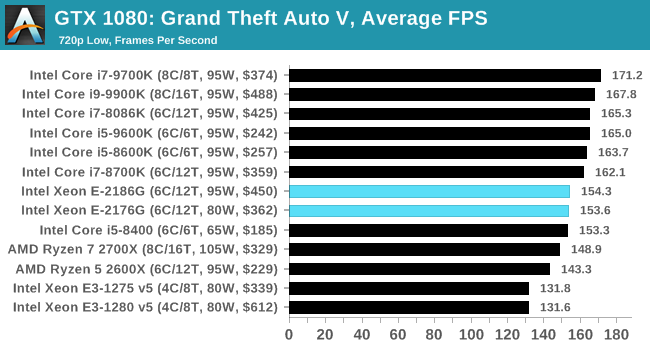 |
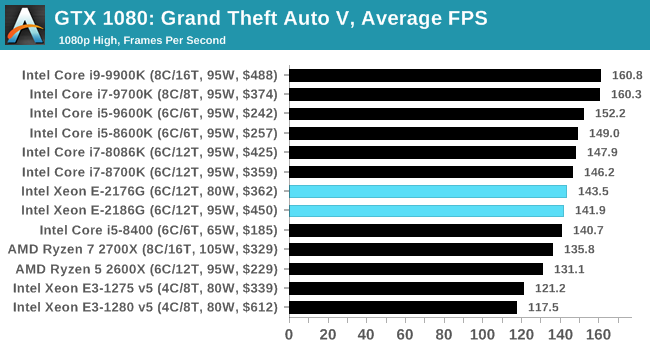 |
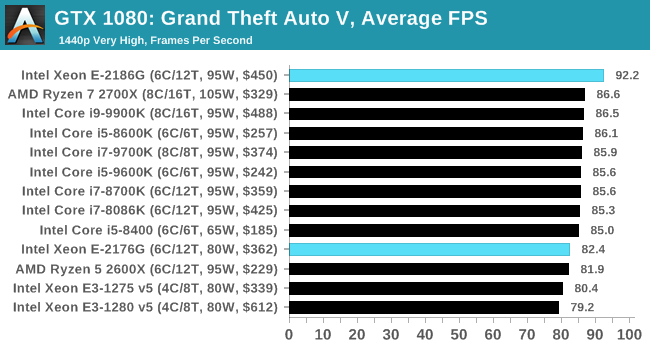 |
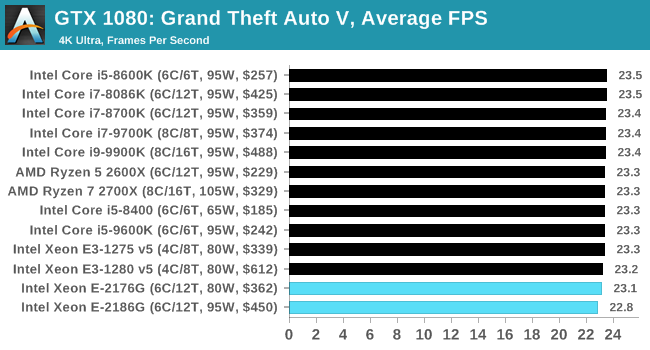 |
| 95th Percentile | 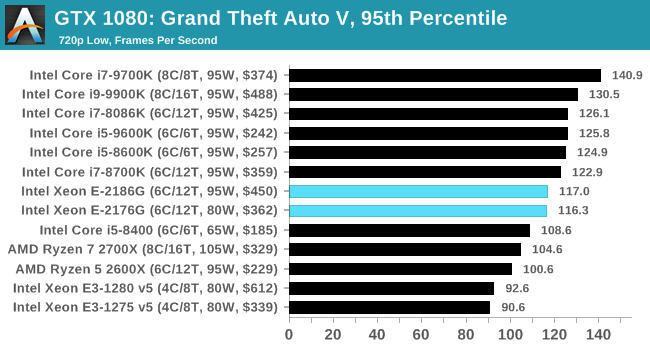 |
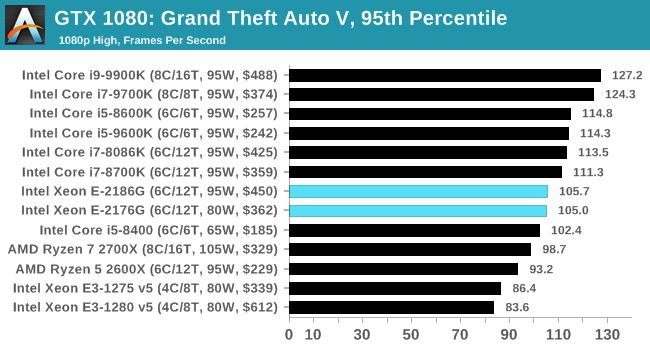 |
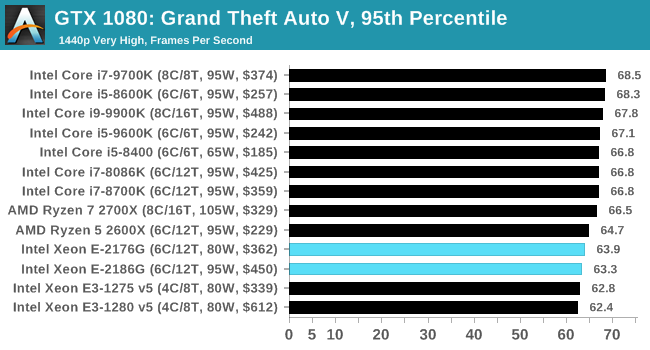 |
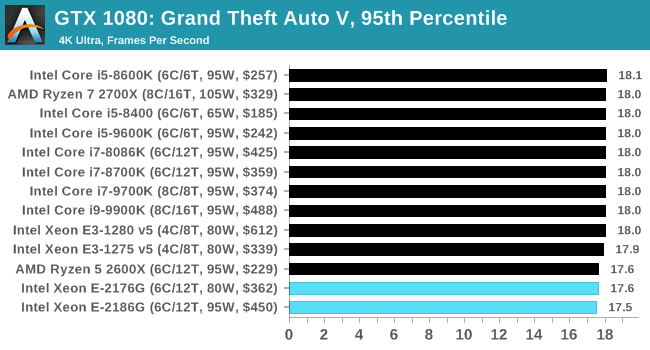 |












48 Comments
View All Comments
Jorgp2 - Monday, November 5, 2018 - link
Why don't you guys test iGPU encoding performance?speculatrix - Tuesday, November 6, 2018 - link
I agree, it would be useful to see video transcode performance, there's a few times when you want a media server with fast video transcode performance (i.e. real time 1080p60).Samus - Tuesday, November 6, 2018 - link
I'd also like to know where Quicksync performance lies on the new Xeons...mooninite - Wednesday, November 7, 2018 - link
Yes! I'd love to see iGPU encoding numbers, too. I would be buying one of these Xeons to get the encoding offloading you couldn't get with a Threadripper or EPYC.kuttan - Sunday, November 11, 2018 - link
For iGPU encoding you don't need a Xeon. For that any IGP based consumer desktop CPUs like Core i3/i5 or AMD Ryzen 2400G APU will do at a much cheaper price.mooninite - Tuesday, November 13, 2018 - link
@kuttan, you don't understand. I need a *server* system that has IPMI. i3/i5 or Ryzen systems don't provide IPMI. I also need a Micro ATX formfactor with 10GBASE-T NICs. Not going to happen on a i3/i5 or Ryzen system. Thanks though.Vidmo - Wednesday, November 7, 2018 - link
Agreed!shiznit - Wednesday, November 21, 2018 - link
no kidding... top 5 use case for these Xeons.just4U - Monday, November 5, 2018 - link
Thru-out the article I kept thinking.. Oh look a 6core product when 8core processors are becoming the norm at reasonable prices in desktop computers. In server settings I wonder why that would even be something to write home about.Ratman6161 - Monday, November 5, 2018 - link
Well, you really have to want/need that ECC RAM to make this worthwhile. Otherwise there is no point to going with an "E" over the equivalent desktop part.